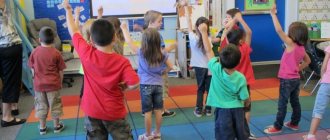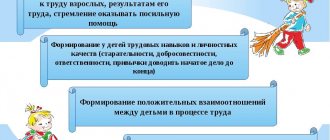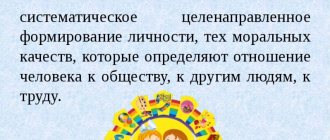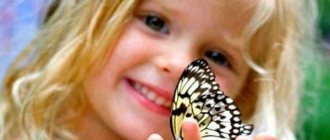Pedagogical advice: Environmental education in kindergarten
Pedagogical Council "Environmental education in kindergarten."
Goal : to improve work in kindergarten to form the foundations of environmental culture in preschoolers. Progress of the teaching council: The amazing world of nature greets the child with a sea of sounds and smells, riddles and secrets, makes him stop, listen, look closely, and think. A field, a meadow, a quiet river, a tiny puddle have their secrets. But wherever the kindergarten is located: in a noisy city or in a quiet village, beyond the Arctic Circle or in the steppe, a teacher who loves nature helps children take their first steps into an unknown country called nature. I invite you to talk about environmental education of children, share your experiences and ideas to improve the efficiency of the educational process. What does the term "Ecology" mean? The word “ecology” itself is derived from the Greek “ekos” - “house” and “logos” - the science of the interactions of living organisms and their communities with each other and with the environment. The term was first proposed by German biologist Ernst Haeckel in 1866. Some possible definitions of the science of “ecology”: • Ecology is the knowledge of the economy of nature, the simultaneous study of all the relationships of living things with organic and inorganic components of the environment... In a word, ecology is a science that studies all the complex relationships in nature. • Ecology is the science of the environment and the processes occurring in it. What is meant by environmental education of preschool children? Environmental education of preschool children involves: – fostering a humane attitude towards nature (moral education); – formation of a system of environmental knowledge and ideas (intellectual development); – development of aesthetic feelings (the ability to see and feel the beauty of nature, admire it, the desire to preserve it); – participation of children in activities feasible for them to care for plants and animals, to preserve and protect nature; – environmental education is a system aimed at the formation of the principles of environmental culture and the development of environmental culture in children and adults; – the system of environmental education is the creation of conditions, certain content, methods and forms of work with children and parents. Why, in your opinion, does environmental education need to start from preschool age? Preschool age is the most favorable period of environmental education. It is at this age that vivid, imaginative emotional impressions, the first natural history ideas accumulate, and the foundation of a correct attitude towards the world around us and a value orientation in it is laid. Love for nature, a conscious, careful and interested attitude towards it in every person should be cultivated from early childhood in the family and kindergarten. What is the role of the teacher in the environmental education of a preschooler? Environmental education of preschoolers should be carried out by a teacher who himself has knowledge in the field of ecology, who loves nature and cares about it. It presents a complex of environmental knowledge in an accessible, exciting form based on the principle of developmental education and aimed at developing the child’s personality. Takes into account interest and age characteristics. In what types of children's activities is it possible to consolidate environmental knowledge? In the process of environmental education, the following types of activities can take place: – role-playing game, reflecting various events in nature or the activities of adults; – practical activities to create or maintain conditions for living objects in the green area of the kindergarten (work in nature), as well as activities to restore objects (repairing toys, books); – children's creativity based on impressions of nature or the activities of people in nature; – communication with nature, contact with objects of flora and fauna; – experimentation: practical cognitive activity with natural objects; – speech activity (questions, messages, participation in conversation, dialogue); exchange of information, impressions, clarification of ideas about nature using words; – observation (independent cognitive activity), providing information about the nature and activities of people in nature; – viewing books, paintings, television programs with natural history content, activities that contribute to obtaining new and clarifying existing ideas about nature; – project activities. In order to develop in children: the need to communicate with representatives of the animal and plant world, cognitive interest in them, the ability to see and understand beauty, the need for self-expression in creative activity, conditions are created in kindergarten where children can, with daily free access, replenish their knowledge, realize the need to communicate with nature. Message from the teacher “Creating an ecological and developmental environment in preschool educational institutions.” Business game Your task is to show knowledge about the life of flora and fauna, the state of the weather, signs according to the folk calendar. 1 part. Warm up. Participants take turns answering the leader’s question. Questions for the first team 1. How is rain formed? (Rain is formed by the condensation of water vapor, which collects in clouds, transforming into clouds, from which drops of water fall onto the surface of the earth. This phenomenon is a consequence and an integral part of the water cycle in nature.) 2. What is fog? (Fog is a form of release of water vapor in the form of microscopic drops or ice crystals, which, collecting in the ground layer of the atmosphere (sometimes up to several hundred meters), make the air less transparent.) 3. Which tree and shrub plants bloom at the same time during spring? and leaf buds? (The maple blooms at the same time as the leaves bloom.) 4. Which trees begin to flow sap the earliest? (At birch and maple). 5. Why don’t cuckoos build nests and hatch chicks? (She picked up this habit a long time ago, because she has evolutionarily adapted to this parasitic method of breeding chicks. Despite its large size, the cuckoo lays small eggs so that small birds do not realize that they have a foundling in their nest. Each species of cuckoo chooses the nest of those birds , whose eggs resemble her own in color, because if they notice the catch, the owners will simply throw away someone else’s egg). 6. Why do bunnies always tremble? (Heat develops in the trembling muscles, which bunny rabbits use to warm themselves.) 7. Which herbaceous plant has pink young flowers and purple flowers in old ones? (At the lungwort). 8. What is a squirrel's nest called? (Gayno. The spherical outside of the nest is disguised with leaves. Spruce branches, the inside is lined with moss, grass, wool, sometimes finely plucked bast. A caring squirrel mother has from three to five nests. When parasites breed in a warm nest, the squirrel transfers the squirrels to another nest. She does the same in a moment of danger.) Questions for the second team 1. How is a rainbow formed? (Rainbows are usually explained by simple refraction and reflection of the sun's rays in raindrops). 2. How can you tell from the snow in a ravine where is south and where is north? (On the southern slope of the ravine, the snow melts faster, so there is less of it there. On the northern slope, the snow melts more slowly, and there is more of it there). 3. Which tree’s leaves never change color and fall green in the fall? (Alder leaves). 4. Which butterflies wake up in the spring and fly out first? (In the spring, the first to fly are urticaria, lemongrass, cabbageweed, and hawthorn). 5. Why do swifts never land on the ground? (On the ground, swifts are helpless - their short legs are adapted only for crawling. A swift is also not able to take off from the ground on its own - its long wings hit the ground when flapping. The absence of a hind finger does not allow it to grasp a branch). 6. Which tree “changes clothes” either gray-silver or green? (Aspen. It’s its leaves that tremble. Aspen leaves tremble even in calm weather, since their petioles in the upper part are strongly flattened.) 7. Which animal is the cleanest? (Badger. Near the hole it is always clean, the badger makes a toilet - deep holes - a few meters from the hole. When the hole is full, the badger buries it and makes a new one. When he goes hunting. He cleans the fur from the earth stuck to it, straightens the hairs crushed in the hole .). 8. Why do nettles “burn”? (The hairs on nettle leaves contain formic acid. When you touch the skin, the tip of the hair breaks, the walls of the hairs containing silica make a wound on the skin, the liquid pours onto the wound and causes a burning sensation.) Part 2. Legends about plants. Plants have played an important role in the life of all peoples since ancient times. There are many different stories associated with them. Each plant has its own history, and a very ancient history has turned into a legend. Teams are offered photographs of plants; participants must determine their name and tell a legend about them. Iris The name of the plant comes from the Greek word iris - “rainbow”. According to ancient Greek mythology, the goddess of the rainbow Iris (Iris) fluttered across the sky on light, transparent, rainbow wings and carried out the orders of the gods. People could see it in raindrops or on a rainbow. A flower was named after the golden-haired Iris, the shades of which were as magnificent and varied as the colors of the rainbow. Viburnum There is such a legend about viburnum. There were once viburnum berries that were sweeter than raspberries. A beautiful girl fell in love with a proud blacksmith, who did not notice her and often wandered through the forest. Nothing helped, and then she decided to burn that forest. The blacksmith came to his favorite place, and everything there burned down. Only one viburnum bush remained, watered with burning tears. And under the bush the blacksmith saw a tear-stained beauty. His heart grew attached to the girl, he fell in love, but it was too late. Along with the forest, the girl’s beauty quickly burned away. And viburnum restored the guy’s ability to respond to love, and in his old age he saw the image of a young beauty in his hunched old woman. But since then, the viburnum berries began to taste bitter, like tears of unrequited love. And there was a belief that a bouquet of viburnum, applied to an aching heart in love, soothes the pain. Lily Ancient Greek myths attributed divine origin to the lily. According to one of them, one day the goddess Hera fed the baby Ares. Drops of splashed milk fell to the ground and turned into snow-white lilies. Since then, these flowers have become the emblem of the goddess Hera. Among the ancient Egyptians, the lily, along with the lotus, was a symbol of fertility. Christians also adopted their love for her, making her a symbol of the Virgin Mary. The straight stem of the lily represents her intelligence; drooping leaves - modesty, delicate aroma - divinity, white color - chastity. According to legend, the lily was held by the Archangel Gabriel when he notified Mary of the imminent birth of Christ. Birch In Russia, birch has been a symbol of grace and purity since ancient times, which personifies Russian nature and Russian woman. One of the legends tells about a beautiful mermaid who lived in a forest lake. At night she came out of the water and frolicked under the moon. However, as soon as the first rays of the sun appeared, the mermaid immediately dived into her cool home. One day she started playing and did not notice how the young sun god Khors appeared in the sky on his solar chariot. He saw the beauty and fell madly in love with her. The mermaid wanted to hide in the lake, but the golden-haired god did not let her go. So she remained standing forever, turning into a beautiful white-trunked birch tree. Part 3. Breaking ring “Weather Bureau” Teams are given envelopes with leaflets. On some the beginning of the sign is written, on others - the continuation. Participants must quickly and correctly collect folk signs. An abundance of snow in January means a rainy summer. Late flowering of rowan - for a long autumn. Abundant dew on the grass means clear, hot weather. The titmouse begins to squeak in the morning - it means frost. Clover folds its leaves to indicate an approaching storm. Lots of berries - for a cold winter. Frogs croak - it means rain. If lightning flashes in early spring, but thunder is not heard, there will be a drought in the summer. Part 4 Solving pedagogical situations. 1. Ira walked home from kindergarten through a park planted with currant bushes and loudly told her mother how the whole group watered them here. But the mother was busy with her own thoughts. - Why are not you listening to me? - Ira asked and pulled out her hand. - What kind of whims is this?! - the mother flared up and, breaking a young currant branch, whipped the girl with it. And then she said angrily: “Who needs your troubles, it’s just a child’s game!” Without you, there will be enough conservationists. What negative consequences could the mother’s action have? 2. In the kindergarten area, the girls play shopping and replenish the assortment of “products” by picking off plants: yellow acacia pods - “beans”, chamomile heads - “sweets”, etc. Irina Petrovna came up and praised: “Well done! Well thought out! »Name the teacher’s mistakes. What would you do in this situation? Summing up the results of the teachers' meeting. Discussion of draft decisions.
We recommend watching:
Analytical report of the preschool educational institution on the organization of work. Section "Environmental Education" Encyclopedia - one of the forms of introducing preschoolers to the natural world of their native land Ecological trail in kindergarten Musical lesson in the senior group on the topic: Winter
Similar articles:
Ecology in music
Plot-based didactic games on ecology in kindergarten for middle group children
Ecological holidays and leisure activities in preschool educational institutions. Scenarios
Speech at the teachers' council "Environmental education of preschool children"
Man and nature... The work of philosophers, poets and artists of all nations and at all times has been devoted to this eternal theme.
But these days this topic is most pressing. The threat of an environmental crisis, and possibly a catastrophe, hangs over humanity. The problem of greening human activity, both material and spiritual, has become vitally necessary. After all, this is an important condition for preserving our common home – the Earth. Environmental education of preschool children includes several areas. From the point of view of moral education, this is a humane attitude towards nature. In terms of intellectual development - the formation of a system of environmental feelings, knowledge and ideas. Also, environmental education includes the development of aesthetic feelings, such as the ability to see and feel the beauty of nature, the ability to admire it, and the desire to preserve it. The participation of children in activities feasible for them to care for plants and animals, to preserve and protect nature, helps to form in them a careful and caring attitude towards the world around them.
In a preschool setting, all components of such an integrated approach exist interconnectedly. After all, a humane attitude towards nature arises in the process of realizing that the world around us is unique and unique, that it needs our care. Consolidation of this attitude occurs in the process of practical activities in caring for indoor plants and the inhabitants of the living area.
To successfully foster a caring attitude towards nature, it is necessary to create an environment in which adults could demonstrate by personal example to children the correct attitude towards nature, and be active, participating together with children in environmental activities.
The following several criteria indicate the formation of a humane attitude towards nature and its awareness.
Firstly, this is an understanding of the need to protect nature. It is based on its practical, moral and aesthetic significance for humans.
Secondly, it is mastering the norms of behavior in the natural environment. As well as compliance with these standards in practical activities.
Thirdly, the manifestation of an active attitude towards natural objects. The ability to evaluate both your own actions and the actions of other people in relation to nature. An expression of effective concern for her.
Thus, since the basis of a person’s relationship with the surrounding world, with nature, is the awareness of the value of life in all its manifestations, the desire to protect and preserve nature, environmental education implies, first of all, moral education, and involves the formation of humane feelings..
In the process of forming a humane attitude towards nature, the teacher should focus on the following: it is very important to form in the child an understanding that man and nature are one whole. By caring for nature, we take care of people and their future. And if something harms nature, then it also harms humans. Therefore, it is immoral to destroy the Home that is common to us all.
V. Sukhomlinsky said that “to enter the life of another living being from the inside, to feel someone else’s pain as one’s own...” a preschool child is helped by his age-related characteristics, such as emotional responsiveness and impressionability, which make him sympathize and empathize. Taking this into account, we can form in children a truly humane attitude towards nature.
An effective attitude towards nature is determined by feelings of compassion and empathy. They are expressed in a willingness to take care of those in need, in protecting those who are offended, in a desire to help those who are in trouble, including animals and plants. An active attitude contributes to mastering the skills and abilities of caring for domestic animals, wintering birds, indoor plants, etc.
Along with this, the ability to empathize and sympathize contributes to the gradual formation of an emotional ban on actions that can cause pain and suffering to a living person.
Therefore, it is very important to show the child that in relation to nature he is on the stronger side and therefore must patronize it, must protect it and take care of it. The child must also learn to see the actions of other people, both his peers and adults, give them a moral assessment and, if possible, counteract inhumane and immoral actions.
It is always necessary to remember that the often inattentive and sometimes cruel attitude of children towards nature can be explained by their lack of the necessary knowledge. Therefore, the education of compassion and empathy should occur in unity with the formation of environmental knowledge accessible to preschool children. The system of environmental knowledge for preschool children includes:
- the idea of natural objects, such as plants and animals, as unique and unrepeatable living beings, their needs and requirements and ways to satisfy these needs;
- understanding the mutual connection between all living beings and their habitat, the adaptability of plants and animals to the conditions of their existence;
- the awareness that all living beings on Earth are connected to each other by a complex system of connections (everyone needs each other, everyone depends on each other, the disappearance of any link breaks the chain, that is, biological balance) and at the same time, each of them has its own ecological food, and all of them can exist at the same time.
Of course, knowledge alone is not enough to form in children a humane attitude towards nature - it is necessary to include it in practical activities feasible for their age, for which in preschool institutions conditions should be created for constant and full communication of children with living nature (for example, a teacher together with children can green up a corner of nature, take care of its inhabitants, plant a flower garden, etc., which, naturally, depends on the capabilities of a particular preschool institution.). And the creation and maintenance of a positive emotional state of children (joy from work done, praised by the teacher, a blooming flower) contribute to the further development of feelings of compassion and empathy.
Forming an awareness of the aesthetic value of natural objects, their beauty and aesthetics, supports and strengthens an active humane attitude towards nature. Therefore, one of the conditions for environmental education is the education of aesthetic feelings.
It would be wrong to think that constant communication with nature alone (excursions to the forest, to the river, walks, etc.) can awaken and develop an aesthetic attitude towards it. It is necessary to draw children’s attention to the beauty of nature (carry out thematic walks, for example, “The transparent forests seem to be turning green like feathers,” “Cherry orchards stand like milk drenched,” etc.), teach them to observe the condition of plants, the behavior of animals, receiving this pleasure and noticing the beauty of life (“What do you like most in the corner of nature? Isn’t this flower incredibly beautiful?”), realizing that beauty is in no way determined by a utilitarian approach (many children believe that what is harmful is ugly). The main thing is to always remember: before teaching children to see beauty and understand the essence of beauty as an aesthetic category, it is necessary to develop their emotional sphere, because the feelings of preschoolers are not yet stable and deep enough, they are selective (“I like this, but I don’t like that”) and subjective (for example , I like the hare because it’s fluffy, but I don’t like the hedgehog because it has a prickly character.
The undoubted value of walks and excursions is that children not only learn to see the beauty of the world around them, but also that at this time they acquire skills of cultural behavior in the natural environment. They get acquainted with plants and animals typical for a given region, with their habitats, both natural (meadow, forest, pond) and created by man (vegetable garden, park, orchard, square). Children learn to protect nature and begin to realize what plants and animals really need.
The teacher’s task is to bring children to the understanding that all of us together and each of us individually are responsible for the Earth and everyone can preserve and increase its beauty.
Author: Ilmira Gumarovna Grigorievskaya, teacher of the kindergarten “Lebedushka” kindergarten, Tatarstan village, Tukaevsky district of the Republic of Tatarstan.
The article is published in the author's edition.






